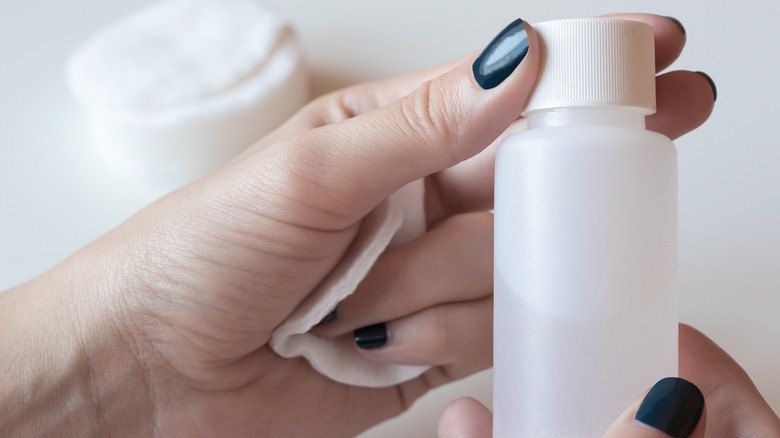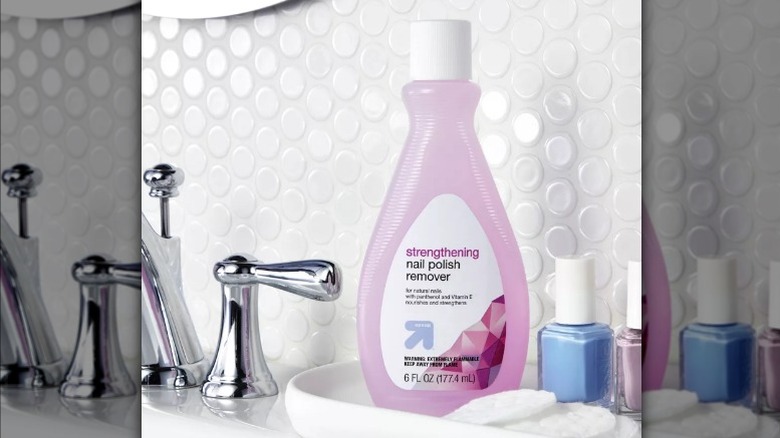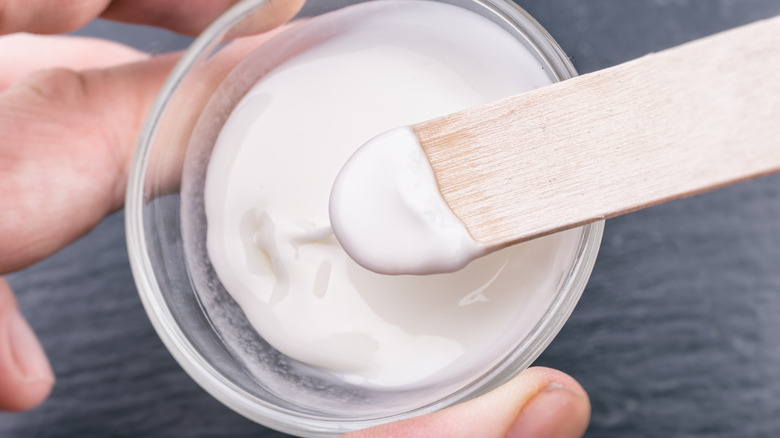Remove Scuffs From Your Tile Floors With Nail Polish Remover
We may receive a commission on purchases made from links.
Tile floors make any interior feel elegant and sleek, but they need to be cleaned regularly and are easily susceptible to scuffs. Even if you're carefully walking around the house, one wrong move and your shoes can betray you — and kids can also create a few scuff marks here and there when they run in and out of the house. Thankfully, there's a quick and easy fix — nail polish remover. You might've heard of using its active ingredient, acetone, to remove scuff marks from shoes; it can also be used on your floors. Acetone is a solvent that breaks down dry nail polish, oils, and other compounds, making it a good contender for scuff marks.
You'll want to solely use the nail polish remover on tile, laminate, or vinyl flooring. Avoid using it on wooden floors because it could damage the surface and remove the finish. In addition, you always want to test a small hidden area of the tile to make sure it's safe to use since it's a harsher product. Instead of buying high-quality scuff remover products, you already have what you need in your bathroom cabinet. Here's how to carefully remove the scuffs from your tiles.
A little acetone goes a long way
Scuff marks can appear on your tile floors from shoes, toys, or furniture, especially chairs that are often moved around. If you've had pesky minor black scuffs on your tile floors that you've tried scrubbing away with soap, throw the soap out and grab your nail polish remover. You'll also want to have two cleaning cloths nearby.
First, add a couple of teaspoons of nail polish remover to one of your rags. Then, gently rub the cloth over the scuff marks until the marks disappear. If your tile flooring has thicker spots, add a couple more teaspoons of acetone to your rag until the scuffs are entirely removed. After you've cleaned the area with the acetone, damp the second clean cloth and wipe away the leftover nail polish remover. Or, you can leave the acetone to dry and mop the tile like you usually do to clean every part. This solution can be used for any room with tile flooring, such as the bathroom, kitchen, hallways, etc.
No acetone? Use baking soda
If you don't have a nail polish remover at home and don't have time to run to the store to buy some, using baking soda is an ideal alternative. You can use it in various areas of your home, even in the most unexpected places. Baking soda works to remove scuff marks because it's mildly abrasive, so it's tough enough to remove but gentle enough to prevent damaging the surface. Again, it's best to test an unnoticeable area with the baking soda to ensure it doesn't ruin the flooring. When using baking soda, you want to make a paste. So, you'll need 2 tablespoons of baking soda mixed with warm water. You want to add a small amount of water at a time to prevent the paste from becoming runny.
Once you've made your paste, add a small amount to a clean cloth or paper towel. Gently rub the paste over the scuffs in a circular motion until you notice them disappearing. You can add more baking soda to your paper towel if you need it. After removing the marks, go over the area with a clean towel to wipe away residue. Finally, dry the area with a new microfiber cloth. On the other hand, you can mop the surface or leave the mopping for your next deep cleaning day.


